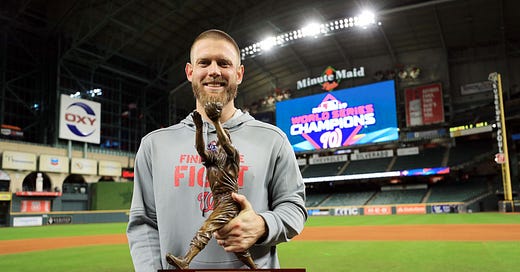Stephen Strasburg went from setback after setback to the surgeon’s table, the second time in the last two years that a nerve issue on his pitching side has ended his season early. The term “neurogenic thoracic outlet syndrome” is confusing, but it doesn’t need to be. TOS in and of itself is essentially saying that the outlets from the body (thorax) to the arm are impeded. If you think of this like a pipe being clogged, what’s being pinched in there in Strasburg’s case is a nerve. Other TOS cases have been blood vessels, but both are bad for varying reasons.
There are a lot of comps with TOS of both types. Famously, we can go as far back as JR Richard and David Cone, to more recent examples of Chris Carpenter, Clayton Richard, Chris Archer, Matt Harvey, and current Rangers GM Chris Young. Keep in mind that the results of more recent cases are far better than those further back. Even if names like Harvey and Archer don’t inspire confidence, they did come back.
While the underlying condition is not exactly the same, the response here is not unlike the case of Peyton Manning. Manning’s nerve impingement was at the spinal level rather than at the arm/shoulder, but the symptoms were very similar. Manning required a spinal fusion to remove the impingement, while the normal surgery removes the first rib to remove the thoracic block. It’s two ends of the same nerve, with similar symptoms.
It’s key to note that while TOS is relatively rare, it’s not uncommon in other areas. In researching a story when Chris Carpenter had surgery, I learned that the most common profession that suffers this is carpenters. The overhead motion combined with impact creates a major problem for some. Guitarists, swimmers, and tennis players also see issues, with an increase in childhood onset TOS that’s been called “backpack palsy” for the root cause of overloaded school packs.
This diagnosis does explain why he was having intermittent issues. As he got to higher and higher effort levels, the nerve took on more stress from the impingement. Surgery should clear up the issue and even on the long end of the rehab, Strasburg will have plenty of time to get back for spring training. Strasburg is 33 and has pitched about 25 innings in the last two years. Does that mean he’s well rested or over the hill? I just don’t know and neither does anyone else. At least, Strasburg has the chance to come back, but there’s no guarantee that something else won’t come up.


Several have asked if his wrist issue from last year, also nerve focused, is related. That’s tough to say, especially in a direct sense. If you define related as ‘things that happen when you put a ton of repetitive stress on your arm’, then yes, they’re related. I asked a doctor if there’s anything else that could go wrong in the area and he said Strasburg’s ulnar nerve was likely moved during his past Tommy John surgery, so the most common areas have been covered.
The history of Stephen Strasburg is not going to be able to be told without being defined by injuries. He went from all-world draftee to Tommy John survivor quickly, then went the better part of a decade with only minor issues - including a neck issue back in 2015 - and ranging anywhere from 210 to 130 innings. He never lost his fastball, even while baseball velocity was exploding, but while he ended up winning a ring with the Nats, he never became the dominant ace that most expected. It’s hard to call his career unsuccessful, but injuries like this are likely the separator between very good and great.




